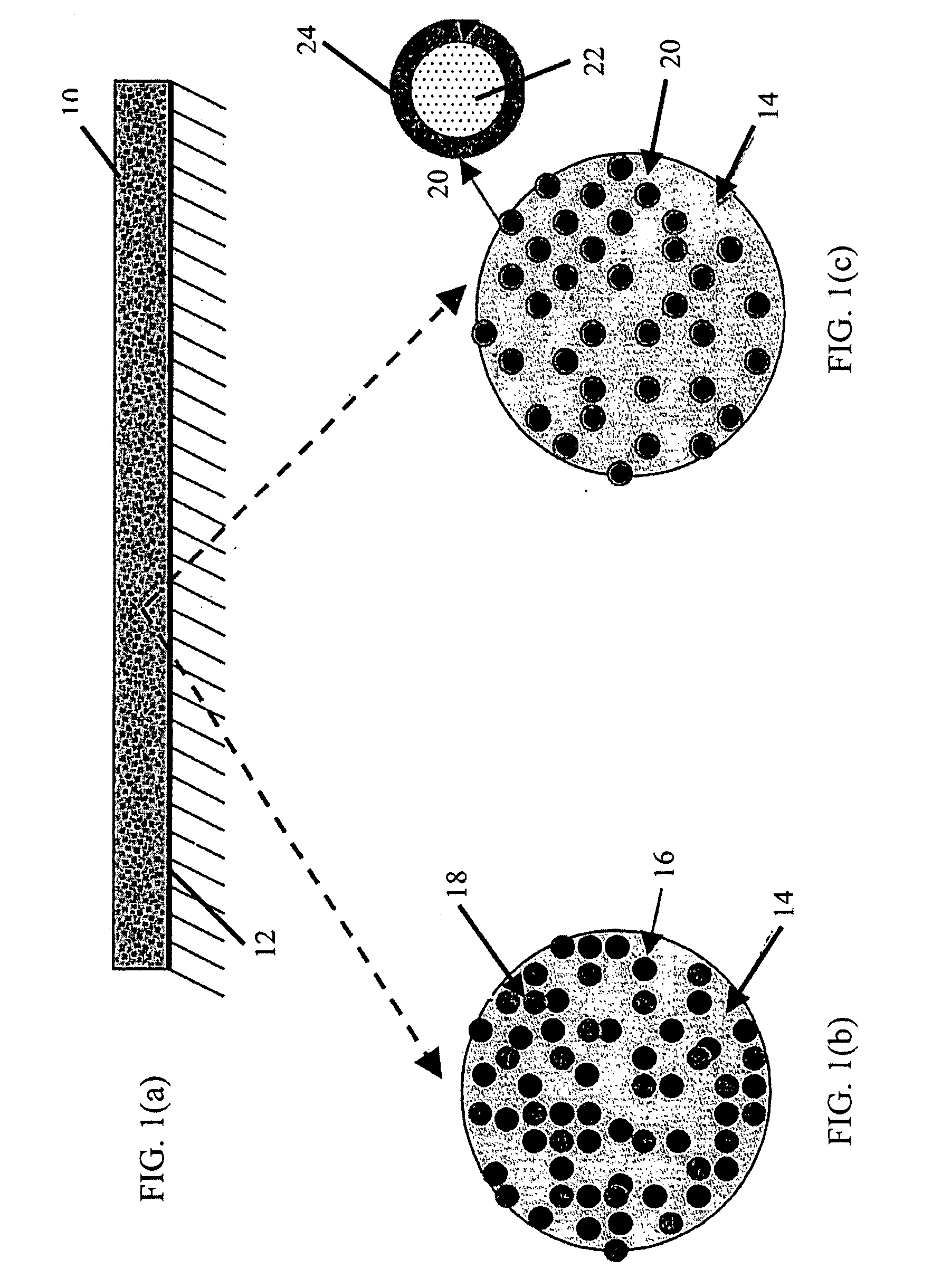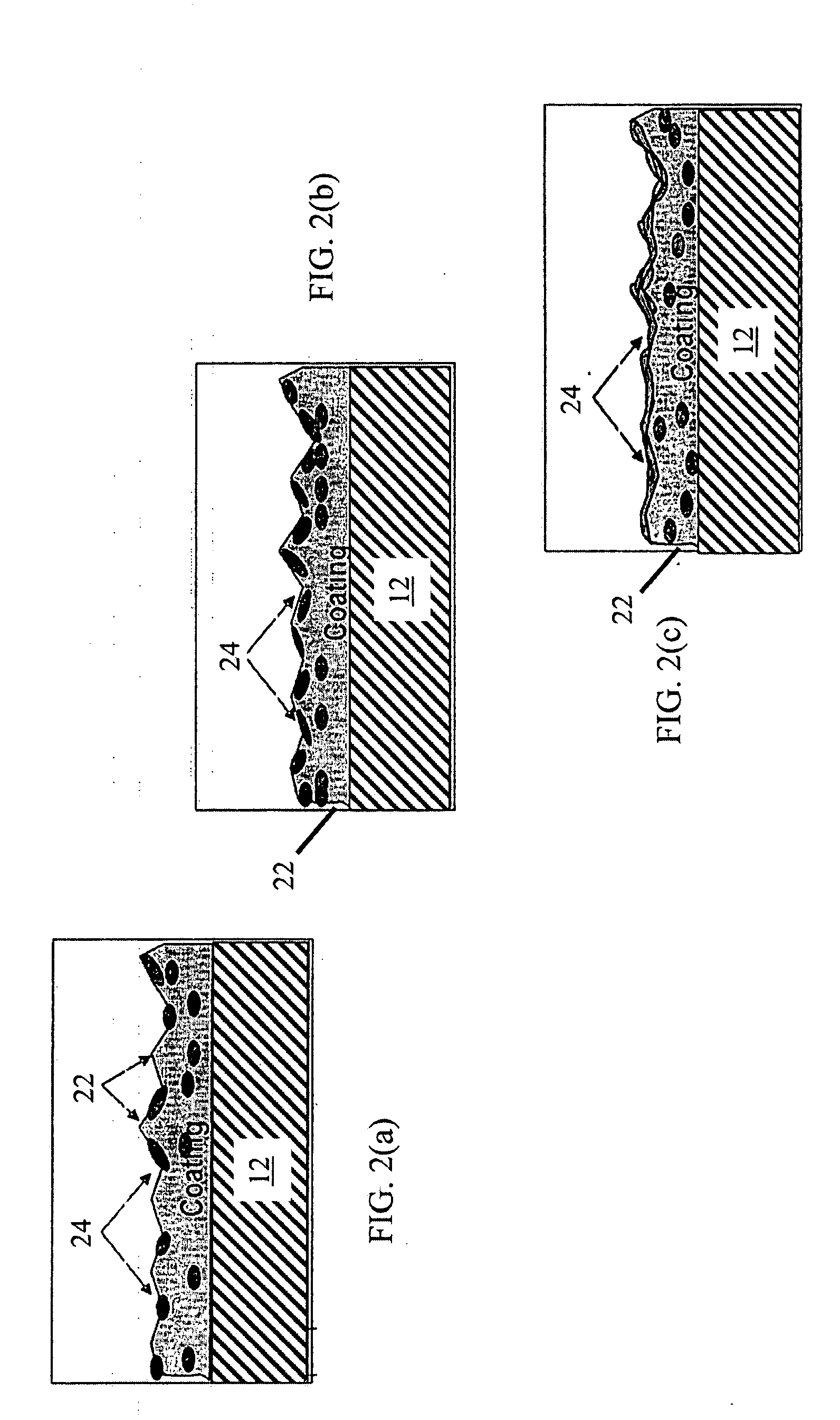Lubricant-hard-ductile nanocomposite coatings and methods of making
a technology of nanocomposite coatings and hard ductile materials, applied in the field of coatings, can solve the problems of limited wear resistance under loss-of-lubricant conditions, limited corrosion protection when used in corrosive systems, and easy deterioration of coatings,
- Summary
- Abstract
- Description
- Claims
- Application Information
AI Technical Summary
Benefits of technology
Problems solved by technology
Method used
Image
Examples
example 1
[0044]In this example, three different electroplating bath compositions were evaluated. In creating a Fe3O4—WC—Ni solution (the first composition), Fe3O4 and WC nanoparticles were ball milled to break down any agglomerated particles: powders. Then 100 grams of Fe3O4 and 100 grams of de-agglomerated WC were dispersed in 2000 grams of nickel sulphamate. Brightener additives (20 grams sodium saccharin) and “leveling agent” (1 gram DARVAN® ammonium polymethacrylate surfactant commercially available from R. T. Vanderbilt Company, Inc.) were added to the solution, followed by deionized (DI) water to form a 5-liter total volume. Finally 0.5 grain of 1,4-butyne-2-diol cataphoretic additive was added. This component specifically adsorbs to the nanoparticles and imparts a positive charge to the species. The surface charge on the particles drives them towards the cathode of the bath. The bath was then maintained at a buffered pH of about 2.7 by the addition of boric acid and an appropriate amo...
example 2
[0053]In this example, a BN—Cr2O313 Ni coating was applied to a metal substrate. The base metal substrate included carbon steel and hardened AS143400 gear alloys. The first step was to remove the surface dirt of the substrate by rubbing it against sandpaper, followed by acetone washing and rinsing with DI water. Degreasing was thereafter performed using the following steps:
[0054]Step 1. Following removal of loose particles from the sample surface (e.g., by light san blasting), the sample was connected to the degreasing bath sample holder.
[0055]Step 2. The samples were anodized for 20 to 30 minutes in the degreasing bath between porous nickel cathodes. The current applied was about 1.6 A for a sample of about 6 square inches. The current was “tuned” based on the alloy of the substrate. A successful “cleaning” was indicated by a faint cloud of dark particles surrounding the sample.
[0056]Step 3. The sample was disconnected and removed from the degreasing bath.
[0057]After degreasing, ri...
example 3
[0068]As shown in FIG. 6, a scanning electron microscopy (SEM) micrograph was taken of a cross-section of one BN—Cr2O3—Ni nanocomposite coating 10 formed on the gear substrate 12. The SEM micrograph revealed that the coating 10 had a very uniform structure throughout its cross-section, with an excellent coating to substrate interface. A transmission electron microscopy (TEM) micrograph was also taken of the cross-section at 75,000× magnification, as shown in FIG. 7. The TEM micrograph revealed excellent bonding between the substrate 12 and the coating 10 at the coating-substrate interface 36. It appeared that total atomic bonding of the coating was achieved. As shown, the gear substrate 12 had a very large grain structure while the nanocomposite coating 10 had a very small grain structure.
[0069]FIG. 8 depicts a more detailed TEM micrograph taken at 150,000× magnification and electron diffraction patterns of the BN—Cr2O3—Ni nanocomposite coating. The micrograph revealed a polycrystal...
PUM
| Property | Measurement | Unit |
|---|---|---|
| thickness | aaaaa | aaaaa |
| thickness | aaaaa | aaaaa |
| surface roughness | aaaaa | aaaaa |
Abstract
Description
Claims
Application Information
 Login to View More
Login to View More - R&D
- Intellectual Property
- Life Sciences
- Materials
- Tech Scout
- Unparalleled Data Quality
- Higher Quality Content
- 60% Fewer Hallucinations
Browse by: Latest US Patents, China's latest patents, Technical Efficacy Thesaurus, Application Domain, Technology Topic, Popular Technical Reports.
© 2025 PatSnap. All rights reserved.Legal|Privacy policy|Modern Slavery Act Transparency Statement|Sitemap|About US| Contact US: help@patsnap.com



